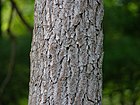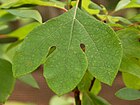Note: This is a project under development. The articles on this wiki are just being initiated and broadly incomplete. You can Help creating new pages.
Difference between revisions of "Sasafras albidum - Sassafras"
m (Prabhakar moved page Sassafras to Sassafras (Sassafras albidum)) |
|||
| (12 intermediate revisions by 2 users not shown) | |||
| Line 1: | Line 1: | ||
[[File:Sassafras7.jpg|thumb|right|''Sassafras'']] | [[File:Sassafras7.jpg|thumb|right|''Sassafras'']] | ||
| + | '''Sassafras''' is a genus of three extant and one extinct species of deciduous trees in the family Lauraceae and it is native to eastern North America and eastern Asia. The genus is distinguished by its aromatic properties, which have made the tree useful to humans. | ||
| + | ==Uses== | ||
| + | {{Uses|Skin irritation}}, {{Uses|Insect bites}}, {{Uses|Cancer}}, {{Uses|Vomiting}}, {{Uses|Kidney problems}}, {{Uses|Gastrointestinal complaints}}, {{Uses|Colds}}, {{Uses|Rheumatism}}, {{Uses|Skin eruptions}} | ||
| − | + | ==Parts Used== | |
| + | {{Parts Used|Leaves}}. | ||
| − | == | + | ==Chemical Composition== |
| + | Six monoterpenes, 2 sesquiterpenes, 6 allylbenzenes, 2 propenylbenzenes, 2 acroleins and 1 benzaldehyde derivative were identified. Eleven out of these 19 sassafras constituents are reported for the first time. However, 1′-hydroxysafrole was not detected.<ref name="chemical composition"/> | ||
| − | Sassafras | + | ==Common names== |
| + | {{Common names|kn=|ml=|sa=|ta=|te=|hi=|en=Augue tree, Sassafras}} | ||
| − | + | ==Properties== | |
| + | Reference: Dravya - Substance, Rasa - Taste, Guna - Qualities, Veerya - Potency, Vipaka - Post-digesion effect, Karma - Pharmacological activity, Prabhava - Therepeutics. | ||
| + | ===Dravya=== | ||
| − | == | + | ===Rasa=== |
| − | + | Tikta (Bitter), Kashaya (Astringent) | |
| − | + | ===Guna=== | |
| − | + | Laghu (Light), Ruksha (Dry), Tikshna (Sharp) | |
| − | + | ===Veerya=== | |
| − | + | Ushna (Hot) | |
| + | ===Vipaka=== | ||
| + | Katu (Pungent) | ||
| + | ===Karma=== | ||
| + | Kapha, Vata | ||
| + | ===Prabhava=== | ||
| + | |||
| + | ==Habit== | ||
| + | {{Habit|Herb}} | ||
| + | |||
| + | ==Identification== | ||
| + | ===Leaf=== | ||
| + | {{Leaf|Simple||The leaves may turn yellow while veins remain green in alkaline soils}}<ref name="Leaf"/> | ||
| + | |||
| + | ===Flower=== | ||
| + | {{Flower|Unisexual|2-4cm long|Greenish-yellow|5-20|Flowers that appear in clusters at the branch ends in spring}} | ||
| + | |||
| + | ===Fruit=== | ||
| + | {{Fruit||7–10 mm|Yellow, weakly fragrant flowers in April; male trees are more showy|Dark blue drupes|}} | ||
| + | |||
| + | ===Other features=== | ||
| + | |||
| + | ==List of Ayurvedic medicine in which the herb is used== | ||
| + | |||
| + | ==Where to get the saplings== | ||
| + | ==Mode of Propagation== | ||
| + | {{Propagation|Seeds}}. | ||
| + | |||
| + | ==How to plant/cultivate== | ||
| + | Landscape Uses:Pest tolerant, Massing, Specimen, Woodland garden. Requires a deep, fertile, well-drained, lime-free, near neutral soil in sun or light shade.<ref name="How to plant/cultivate"/> | ||
| + | |||
| + | ==Commonly seen growing in areas== | ||
| + | {{Commonly seen|Deciduous woodlands}}, {{Commonly seen|Thickets on rich sandy well-drained soils}}. | ||
| + | |||
| + | ==Photo Gallery== | ||
| + | <gallery class="left" caption="" widths="140px" heights="140px"> | ||
| + | Image:Sassafras albidum Trunk Bark 3264px.jpg | ||
| + | Image:Sassafras Sassafras albidum Leaf 2505px.jpg | ||
| + | Sassafras albidum - Köhler–s Medizinal-Pflanzen-260.jpg | ||
| + | Sassafras albidum flower.jpg | ||
| + | </gallery> | ||
| + | |||
| + | ==References== | ||
| − | |||
| − | |||
<references> | <references> | ||
| − | <ref name=" | + | <ref name="chemical composition">[https://www.sciencedirect.com/science/article/abs/pii/S0031942200974806 Chemical constituents]</ref> |
| + | <ref name="Leaf">[https://plants.ces.ncsu.edu/plants/all/sassafras-albidum/ Plant decsription]</ref> | ||
| + | <ref name="How to plant/cultivate">[https://www.pfaf.org/user/plant.aspx?LatinName=Sassafras+albidum Cultivation details]</ref> | ||
</references> | </references> | ||
| − | == External Links == | + | ==External Links== |
| − | + | * [https://www.sciencedirect.com/topics/medicine-and-dentistry/sassafras Sasafras albidum on science direct] | |
| − | *[https:// | + | * [http://www.missouribotanicalgarden.org/PlantFinder/PlantFinderDetails.aspx?kempercode=i820 Sasafras albidum on missouri botonical garden] |
| + | * [https://www.gardeningknowhow.com/ornamental/trees/sassafras/what-is-a-sassafras-tree.htm Where Do Sassafras Trees Grow] | ||
| + | * [https://www.gardeningchannel.com/how-to-grow-a-sassafras-tree/ Sasafras albidum on gardening channel informtion.in] | ||
[[Category:Herbs]] | [[Category:Herbs]] | ||
| + | [[Category:Lauraceae]] | ||
Latest revision as of 18:21, 4 August 2020
Sassafras is a genus of three extant and one extinct species of deciduous trees in the family Lauraceae and it is native to eastern North America and eastern Asia. The genus is distinguished by its aromatic properties, which have made the tree useful to humans.
Contents
- 1 Uses
- 2 Parts Used
- 3 Chemical Composition
- 4 Common names
- 5 Properties
- 6 Habit
- 7 Identification
- 8 List of Ayurvedic medicine in which the herb is used
- 9 Where to get the saplings
- 10 Mode of Propagation
- 11 How to plant/cultivate
- 12 Commonly seen growing in areas
- 13 Photo Gallery
- 14 References
- 15 External Links
Uses
Skin irritation, Insect bites, Cancer, Vomiting, Kidney problems, Gastrointestinal complaints, Colds, Rheumatism, Skin eruptions
Parts Used
Chemical Composition
Six monoterpenes, 2 sesquiterpenes, 6 allylbenzenes, 2 propenylbenzenes, 2 acroleins and 1 benzaldehyde derivative were identified. Eleven out of these 19 sassafras constituents are reported for the first time. However, 1′-hydroxysafrole was not detected.[1]
Common names
| Language | Common name |
|---|---|
| Kannada | |
| Hindi | |
| Malayalam | |
| Tamil | |
| Telugu | |
| Marathi | NA |
| Gujarathi | NA |
| Punjabi | NA |
| Kashmiri | NA |
| Sanskrit | |
| English | Augue tree, Sassafras |
Properties
Reference: Dravya - Substance, Rasa - Taste, Guna - Qualities, Veerya - Potency, Vipaka - Post-digesion effect, Karma - Pharmacological activity, Prabhava - Therepeutics.
Dravya
Rasa
Tikta (Bitter), Kashaya (Astringent)
Guna
Laghu (Light), Ruksha (Dry), Tikshna (Sharp)
Veerya
Ushna (Hot)
Vipaka
Katu (Pungent)
Karma
Kapha, Vata
Prabhava
Habit
Identification
Leaf
| Kind | Shape | Feature |
|---|---|---|
| Simple | The leaves may turn yellow while veins remain green in alkaline soils |
Flower
| Type | Size | Color and composition | Stamen | More information |
|---|---|---|---|---|
| Unisexual | 2-4cm long | Greenish-yellow | 5-20 | Flowers that appear in clusters at the branch ends in spring |
Fruit
| Type | Size | Mass | Appearance | Seeds | More information |
|---|---|---|---|---|---|
| 7–10 mm | Yellow, weakly fragrant flowers in April; male trees are more showy | Dark blue drupes | {{{6}}} |
Other features
List of Ayurvedic medicine in which the herb is used
Where to get the saplings
Mode of Propagation
How to plant/cultivate
Landscape Uses:Pest tolerant, Massing, Specimen, Woodland garden. Requires a deep, fertile, well-drained, lime-free, near neutral soil in sun or light shade.[3]
Commonly seen growing in areas
Deciduous woodlands, Thickets on rich sandy well-drained soils.
Photo Gallery
References
External Links
- Ayurvedic Herbs known to be helpful to treat Skin irritation
- Ayurvedic Herbs known to be helpful to treat Insect bites
- Ayurvedic Herbs known to be helpful to treat Cancer
- Ayurvedic Herbs known to be helpful to treat Vomiting
- Ayurvedic Herbs known to be helpful to treat Kidney problems
- Ayurvedic Herbs known to be helpful to treat Gastrointestinal complaints
- Ayurvedic Herbs known to be helpful to treat Colds
- Ayurvedic Herbs known to be helpful to treat Rheumatism
- Ayurvedic Herbs known to be helpful to treat Skin eruptions
- Herbs with Leaves used in medicine
- Herbs with common name in English
- Habit - Herb
- Index of Plants which can be propagated by Seeds
- Herbs that are commonly seen in the region of Deciduous woodlands
- Herbs that are commonly seen in the region of Thickets on rich sandy well-drained soils
- Herbs
- Lauraceae




